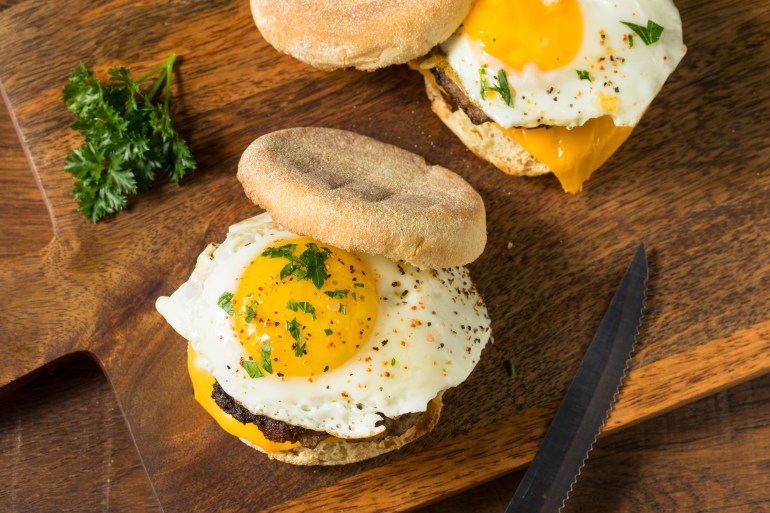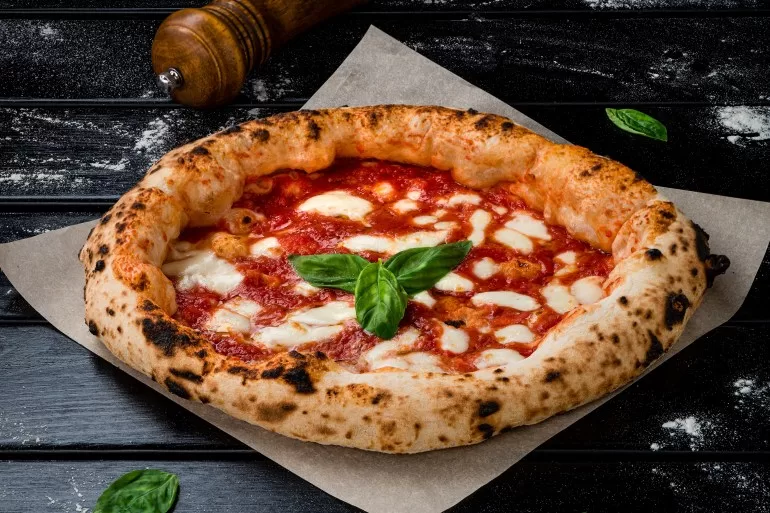You might have heard the story about pasta originating in China due to Marco Polo’s accounts of eating Chinese noodles in one edition of Marvels of the World, the book documenting his travel experiences from 1271 to 1295.
That myth has been debunked by food historians who, like Italian TV chef and food historian Anna Maria Pellegrino, have pointed out that “there’s no direct link” between pasta and noodles.
“The way they are cooked, the pots, the types of cereals used, the preparation, ingredients and toppings are completely different and specific to each civilisation,” Pellegrino explained in a Singaporean newspaper in 2020.
Furthermore, food historians said durum wheat, a key ingredient in pasta, could not have been cultivated in China in Marco Polo’s time.
There are, however, many foods that do have surprising or unexpected origins.
Many of these foods are what we’d now call fusion cuisine or food fusion, in which ingredients and cooking techniques from different regions are merged, sometimes out of necessity and sometimes out of mere creativity.
Although it’s difficult to pinpoint exactly when cuisine from different countries started to be adapted, it probably began with the spice trade, which started around the first century AD.
Known as the Maritime Silk Road, the trade route allowed goods to be traded as far away as 15,000km (9,320 miles) from the Middle East to the Mediterranean and beyond. The Silk Road, dating back to 130 BC already facilitated the exchange of spices, grains and cooking methods between Asia, the Middle East and Europe.
How did fusion food arise?
As people moved, they carried their cultural heritage with them, including cooking techniques and recipes, blending them with new flavours and ingredients. As a result of the transatlantic slave trade, the African diaspora introduced African ingredients and cooking styles to the Americas, helping to develop Creole and Cajun cuisines.
In the 19th and 20th centuries, waves of immigrants from Italy, China and Mexico to the United States created a melting pot of culinary traditions, resulting in dishes like pizza, chow mein and tacos becoming staples of Western food culture.
Although the source of reinvented dishes is often viewed through ingredients alone, recipes can take on a new form when people move to new countries where local ingredients are different.
There are the obvious food fusions like Korean tacos (origin: Los Angeles – not Korea or Mexico) or butter chicken pizza (certainly not from India, more likely Canada), where two types of food originating in different places are combined.
Then there are less obvious examples like chicken tikka masala, which was most likely born in 1950s Glasgow, Scotland. This dish – with its thick tomato-based gravy reminiscent of the gravies popularly used in British meals – is an example of a slightly different type of fusion where a type of food from one place is adapted to the tastes, available ingredients and even cooking styles and methods of another place.
“Fusion food is at least two distinct food cultures, traditions coming together to create like the matzo ramen, or like, there’s a place on the Lower East Side [of Manhattan] called Mahal Taco that does tacos but in naan bread instead of a tortilla. Like that is like distinct fusion food,” Victoria Flexner, food historian and author of A History of The World in Ten Dinners, told Al Jazeera.
“Whereas I think adaptation is maybe a bit more … where a dish gets adapted to a new country and maybe a lot of people in that country don’t eat beef or pork or there’s an ingredient in the dish that just doesn’t grow in that country at all.”
Here are the stories behind some of your favourite fusion or adapted foods:
New York-style pizza
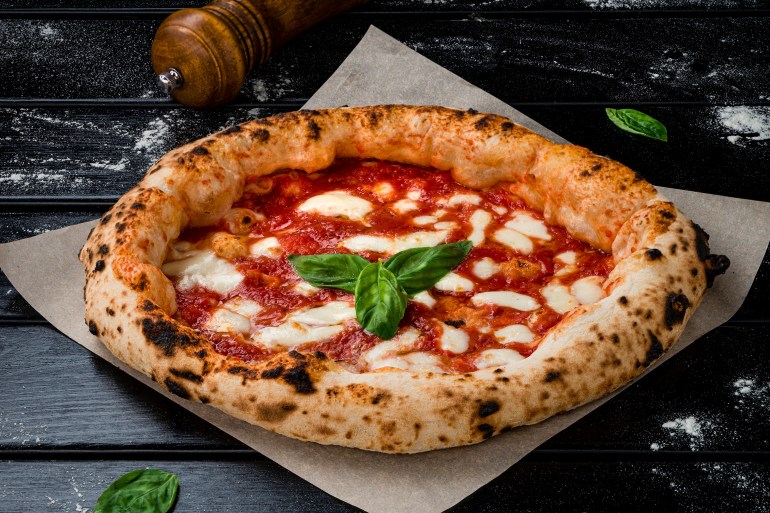
In 1905, Gennaro Lombardi, an Italian immigrant from Naples, opened the first pizzeria in the US in the Little Italy neighbourhood of Manhattan.
In Italy, the traditional pizza was cooked in a wood-fired oven. But Lombardi was forced to adapt to cook in a coal oven, fundamentally altering the taste and texture.
According to Scott Weiner, a “pizza historian”, it was all down to cost. In an article in Serious Eats, a popular food blog, he writes: “Those who have experienced the goodness of a coal-fired oven may take for granted the resulting pizza’s crisp yet chewy texture. Coal was already a dominant heating fuel when Neapolitan immigrants landed in the US in the 1880s. Newly arrived bakers used hard coal instead of wood to heat their ovens because it took up less space and burned more efficiently.”
That’s not all. The classic Neapolitan pizza also had to adapt to the hustle and bustle of New Yorkers on the move and in need of something to take to work to eat for lunch. This opened the door for pizza to be sold by the slice. Food historians attribute this invention to Frank Maestro, an Italian immigrant and salesman who ran a restaurant-supply business.
In 1934, Maestro also installed a gas line in his oven and started experimenting with it to make pizza.
On Special Sauce, a podcast for food lovers, Wiener explains the transition: “Suddenly, the max oven temperature drops by 400 degrees Fahrenheit [220 degrees Celsius]. So now that you’re in the 500-550F [260-288C] range, the pizzas take longer to bake and are baking up drier. But they also have a longer shelf life because more of the water is cooked out, so they’re reheatable. Pizza by the slice is – has to be – reheated most of the time. So that oven is a big deal.”
General Tso’s chicken
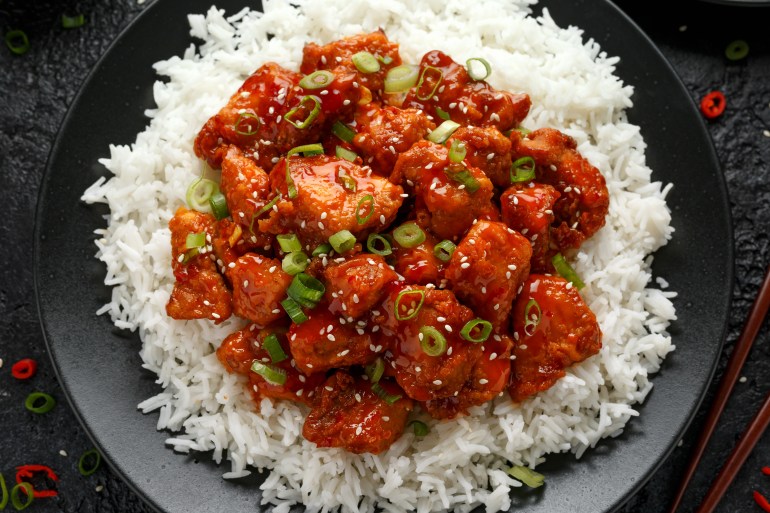
Contrary to popular belief, General Tso’s chicken is not from China. Although the dish is quite popular in American-Chinese fast-food restaurants, it’s not a traditional dish from mainland China. It was invented in Taiwan in the 1950s, becoming popular there and later in the US.
The sugary and spicy fried chicken dish was invented in the 1950s by Peng Chang-kuei, a chef who had fled the Chinese Communist Revolution to Taiwan in 1949. In 1952, Peng opened up a restaurant in Taipei called Peng’s Garden Restaurant. Peng was the official chef for Taiwan’s Nationalist government. Due to US support of the Nationalists against China’s Communist government during the First Taiwan Strait Crisis, many US military dignitaries would visit Taiwan to shore up support for the war.
In 1955, Peng was responsible for a banquet attended by dignitaries including Admiral Arthur W Radford, the chairman of the US Joint Chiefs of Staff, and wanted to come up with something special.
The resulting dish was named after Zuo Zongtang, a 19th-century military hero known for suppressing several significant uprisings and rebellions that led to the stability of the Qing Dynasty. Zuo, like Peng, was from China’s Hunan province.
When Peng emigrated to the US in the early 1970s, he took General Tso’s chicken with him. He opened a restaurant called Uncle Tai’s Hunan Yuan on East 62nd Street in New York City.
According to a 2016 interview with Great Big Story, a London-based film company, Peng Tie-cheng, the son of the inventor of General Tso’s chicken, describes how the dish’s popularity soared because of Henry Kissinger, a former US secretary of state who loved the dish.
The son said: “Because Mr Kissinger liked General Tso’s chicken very much, the US media wrote about it a lot. General Tso’s chicken started to influence the food culture in the US, especially that of Chinese restaurants in the US.”
The original recipe is different from the American version, which is somewhat sweeter and crispier due to US tastes. Peng Tie-cheng said other additions, such as green peppers and even ketchup in some recipes, have also been made.
Caesar salad
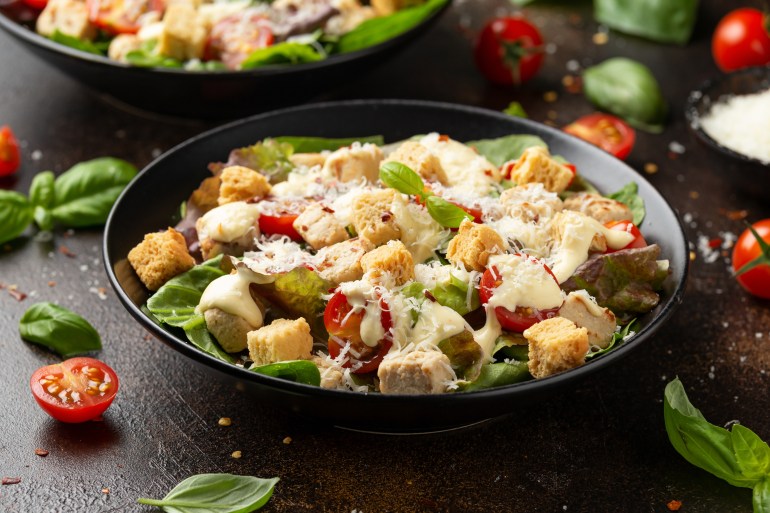
When you think of Caesar salad, you might think of Rome, but Caesar salad was invented thousands of kilometres away from Italy in Mexico. In 1913, two Italian brothers, Caesar and Alex Cardini, emigrated to the US. Caesar established a restaurant in California in 1919 and another restaurant, Caesar’s Place, in the Mexican border town of Tijuana in 1920.
The Prohibition era in the 1920s in the US boosted the popularity of Tijuana, Mexico, where Americans could order a drink, gamble and participate in other activities that were forbidden on the US side of the border.
As the story goes, on July 4, 1924, the beginning of the US Independence Day holiday weekend, Caesar was hard at work in the kitchen but quickly ran out of ingredients for a standard menu item. Although it’s unclear what the original item was, Caesar improvised and cobbled together what he had available: romaine lettuce with a dressing made from coddled (one-minute boiled) eggs, olive oil, black pepper, lemon juice, garlic and Parmesan cheese.
In a slightly different version of the salad’s origin story, Alex said Caesar’s salad was a variation of his own invention, the aviator’s salad. Alex had been a pilot during World War I and named the salad in honour of pilots he served with from Rockwell Field Air Force base in Southern California. His version included anchovy paste.
According to food historians, the original version of the salad in the brothers’ restaurant was eaten by hand using the entire Romaine leaf to scoop up the rest of the salad, instead of the way many serve it today with the lettuce cut up into smaller pieces.
Barbecue
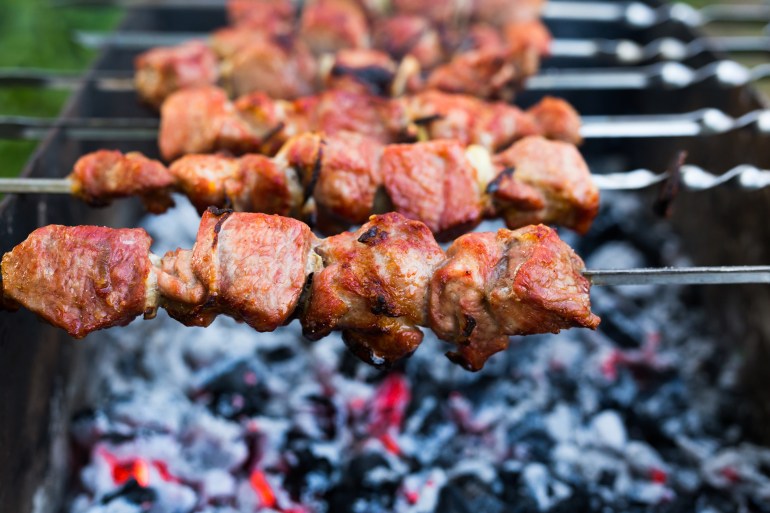
Although barbecue – cooking meat over an open flame – is a tradition that dates back to the start of civilisation, the modern day barbecue originates in several different parts of the world at different times and in different styles.
For instance, the Korean barbecue tradition, known as gogi-gui, in which thin strips of meat are grilled over flames, dates back about 2,000 years while churrasco, meaning “grilled meat”, emerged in 17th century Brazil.
According to food historians, during the Japanese colonial period in Korea (1910-1945), the barbecue traditions of Korean immigrants were introduced to Japan, leading to the emergence of yakiniku, which also means “grilled meats”, in the early 20th century.
The asado has deep roots in the gauchos, the cowboys of Argentina’s Pampas region. In the 18th century, cattle herders devised a distinct technique for grilling meat over open flames, establishing the foundation for the present-day asado.
In South Africa, braaivleis, a Dutch term also meaning – you guessed it – “grilled meat”, has its origins in the cuisine of Indigenous groups such as the Khoikhoi and San communities who have been grilling meat over an open flame for thousands of years.
In the 17th century, Dutch settlers encountered the grilling practice of the Khoisan people and would eventually combine some of their own culinary traditions to create the modern-day braai, an Afrikaans term for barbecue or grill.
The origin of American-style barbecue dates back to Indigenous people native to North America. Enslaved Africans in the American South are said to have adapted those open-fire techniques.
Historians also established a connection between how the Taino Indians in the Caribbean barbecued with a raised platform and the Spanish explorers who are believed to have brought that technique from the Caribbean to the Americas in the 1400s, a precursor to the American-style barbecue we know today.
In a September issue of Texas Monthly, Joseph R Haynes, author of From Barbycu to Barbecue: The Untold History of an American Tradition, wrote: “[Barbecue] was born after enslaved Africans were brought to Virginia in 1619 from West Africa. Eventually, enslaved people of African descent, along with people of European descent, and others of American Indian descent combined their cooking traditions and created what we today call southern barbecue.”
Chicken tikka masala
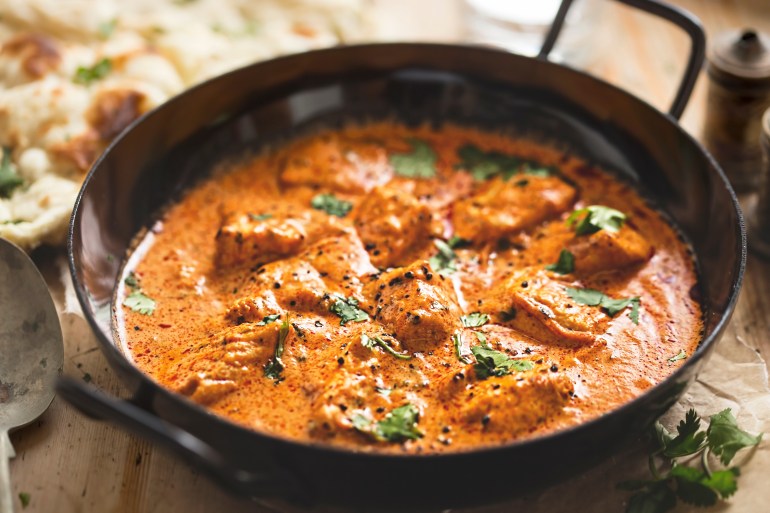
Chicken tikka masala, a popular dish in the United Kingdom, is very likely not from India. The dish is believed to have been created in Glasgow, Scotland, by a Bengali immigrant named Ali Ahamd Aslam, who opened a restaurant called Shish Mahal there in the 1950s.
According to food historians, the idea for chicken tikka masala was born with a complaint about bland, dry chicken. Once the offending dish was sent back to the kitchen, Aslam added tomato soup, yogurt and a blend of spices, and chicken tikka masala was born.
Unlike the legal battle that has recently been taking place in Delhi courts over who is the creator of butter chicken, chicken tikka masala has not triggered an ownership battle.
In a 2001 speech, then-British Foreign Secretary Robin Cook said: “Chicken tikka masala is now a true British national dish not only because it is the most popular but because it is a perfect illustration of the way Britain absorbs and adapts external influences.”
German chocolate cake
This chocolate layer cake topped with a coconut-pecan frosting is not from Germany.
It was named after Sam German from Dallas, Texas. In 1852, he invented a dark chocolate for the Baker’s Chocolate Company, which was later named after the inventor, Baker’s German’s Sweet Chocolate.
After a recipe for “German’s chocolate cake” was printed in a Dallas newspaper in 1957, the cake gained popularity. The possessive was mistakenly dropped from articles about it in several newspapers, which eventually led to the recipe being named German chocolate cake.
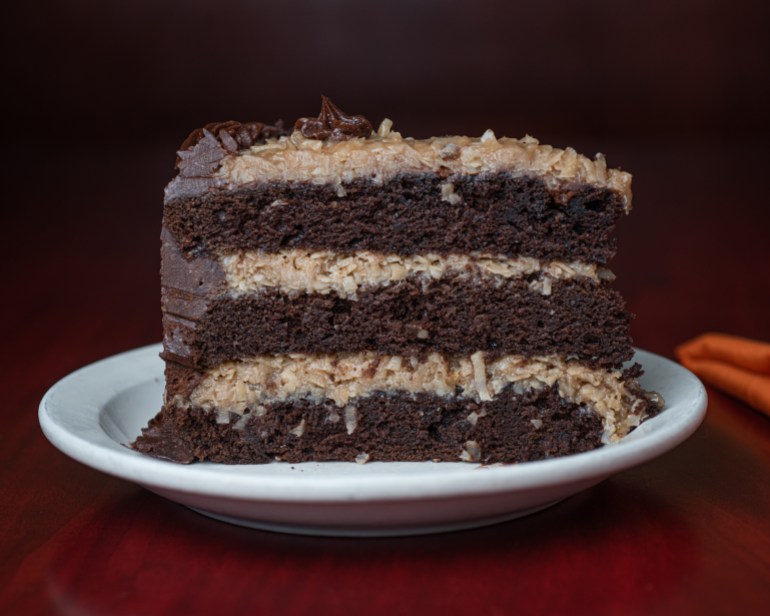
English muffin
A thinner version of the traditional English crumpet, sometimes known as a toaster crumpet, was invented in 1874 by a British man, Samuel Bath Thomas, who had moved to New York City from Plymouth, England.
The English muffin, although inspired by the English crumpet, should really be called the American crumpet. According to food historians, Thomas used the term toaster crumpet as a way to market the product as an alternative to toasted bread to Americans in high-end hotels.
Unlike a traditional crumpet, which is cooked on one side, the distinctive ridges on the inside of the thin crumpet were created when Thomas baked the crumpet on a hot griddle on both sides, allowing for a crispy outside and pillowy inside.
